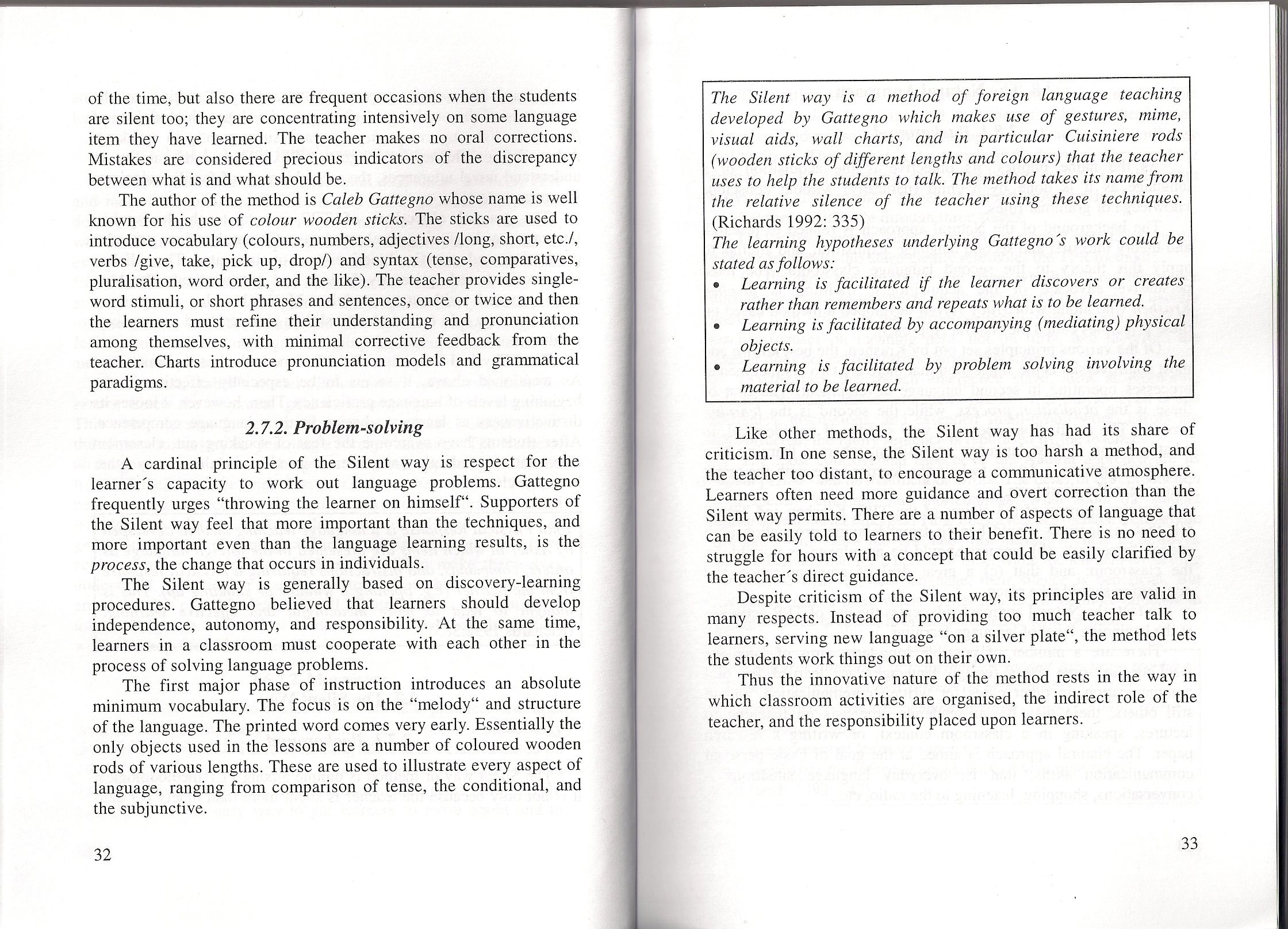46943 skanowanie0016 (36)

of the time, but also there are freąuent occasions when the students are silent too; they are concentrating intensively on some language item they have learned. The teacher makes no orał eorrections. Mistakes are considered precious indicators of the discrepancy between what is and what should be.
The author of the method is Caleb Gattegno whose name is well known for his use of colour wooden sticks. The sticks are used to introduce vocabulary (colours, numbers, adjectives /long, short, etc./, verbs /give, take, pick up, drop/) and syntax (tense, comparatives, pluralisation, word order, and the like). The teacher provides single-word stimuli, or short phrases and sentences, once or twice and then the leamers must refine their understanding and pronunciation among themselves, with minimal corrective feedback from the teacher. Charts introduce pronunciation models and grammatical paradigms.
2.7.2. Problem-sohing
A Cardinal principle of the Silent way is respect for the learner's capacity to work out language problems. Gattegno freąuently urges “throwing the leamer on himselfSupporters of the Silent way feel that morę important than the techniąues, and morę important eyen than the language leaming results, is the process, the change that occurs in individuals.
The Silent way is generally based on discovery-leaming procedures. Gattegno believed that learners should develop independence, autonomy, and responsibility. At the same time, learners in a classroom must cooperate with each other in the process of solving language problems.
The first major phase of instruction introduces an absolute minimum vocabulary. The focus is on the “melody“ and structure of the language. The printed word comes very early. Essentially the only objects used in the lessons are a number of coloured wooden rods of various lengths. These are used to illustrate every aspect of language, ranging from comparison of tense, the conditional, and the subjunctive.
The Silent way is a method of foreign language teaching developed by Gattegno which makes use of gestures, mime, visual aids, wali charts, and in particular Cuisiniere rods (wooden sticks of different lengths and colours) that the teacher uses to help the students to talk. The method takes its name from the relative silence of the teacher using these techniąues. (Richards 1992: 335)
The leaming hypotheses underlying Gattegno's work could be stated as follows:
• Leaming is facilitated if the leamer discovers or creates rather than remembers and repeats what is to be learned.
• Leaming is facilitated by accompanying (mediating) physical objects.
• Leaming is facilitated by problem solving involving the materiał to be leamed.
Like other methods, the Silent way has had its share of criticism. In one sense, the Silent way is too harsh a method, and the teacher too distant, to encourage a communicative atmosphere. Learners often need morę guidance and overt correction than the Silent way permits. There are a number of aspects of language that can be easily told to learners to their benefit. There is no need to struggle for hours with a concept that could be easily clarified by the teacher's direct guidance.
Despite criticism of the Silent way, its principles are valid in many respects. Instead of providing too much teacher talk to learners, serving new language “on a silver plate“, the method lets the students work things out on their own.
Thus the innovative naturę of the method rests in the way in which classroom activities are organised, the indirect role of the teacher, and the responsibility placed upon learners.
33
Wyszukiwarka
Podobne podstrony:
skanowanie0082 (2) comprehension on the part of the students, they will not be able to reproduce it;
48H. Maruszczak, M. Wilgat In the years 1976-1985 they constituted as much as 36% of the total solut
118 T. Wilgat et al. Although the amount of circulating water is smali, there are nunerous lakes — n
69745 mbs 028 MY BREATHING SYSTEM When the mucous membranc of the nose has become too cold, it is no
CCF20110611�019 ^/hat aro tho rritoria for ronrcohook awalmtion? m - A«rvtó -nś ■ background of the
Microprocessor and InterfacingLaboratory Manuał Enrollment No._ Name of the student: Government
AMiracleon 107th Street is the traditional title of the Student Councll Chnsl rnds Banguet
img031 (13) mm « g £ - -Word list Some of these words appear in the transcripts at
Access 3 MID TEST 1 5 cz 2 MID TEST (Modutes 1-S) r 19 I didn t like the..........
Access 3 MID TEST 1 5 cz 2 MID TEST (Modutes 1-S) r 19 I didn t like the..........
więcej podobnych podstron